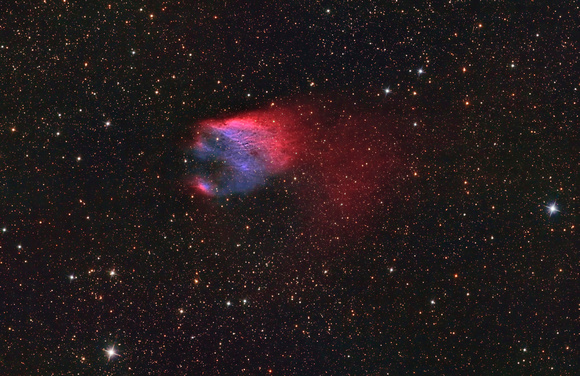A PN in a Windstorm (Sh2-68 in NB/LRGB, Serpens)
A PN in a Windstorm (Sh2-68 in NB/LRGB, Serpens)
Planewave CDK12.5; AP 1100GTO AE
ASI6200MM, - Antlia Pro RGB & 3.5nm NB filters
Ha/O: (43,45 x 480s exposures, Bin 1x1, Gain 200)
R,G,B: (36,32,26 x 240s, Bin 1x1, Gain 100)
L: (39 x 240s, Bin 1x1, Gain 100)
Total Integration Time = 20.6 hours
Sh2-68, or the “Flaming Skull Nebula” is indeed a planetary nebula. Like many it has an inner core, rich in [O+2] blue signal and a red outer shell, rich in Ha signal. Its progenitor star, now a white dwarf, can also be made out as the small blue/green star near the roof of the mouth of the “skull” supplying UV power that makes the PN light up.
In contrast to most others, this PN is much more highly asymmetric about its progenitor. Sh2-68, is in fact within an all-but-invisible molecular cloud moving roughly from left to right across the image frame. To the PN, this is the equivalent of being located in a strong wind. To me, the PN looks like face/head of someone on roller coaster, with the wind blowing its hair (red, Ha) and even skin (blue) off of its face. The prevailing winds are quite turbulent, etching ridges into the planetary nebulas shells as the gases are eroded away.
Sorry about the tech-speak, but my fluid mechanics and mathematical modelling background see the Navier-Stokes equation at work here, and to me this is extremely interesting subject matter. I am left guessing as to the physical properties of the gases – both in the PN and in the molecular cloud wind. The blue and red showing gases must be much more dense and viscous than the gases / radiation blowing across the PN, but both are so rarefied that their properties cannot be measured in a lab down here on earth. At the same time, the fractal geometry of molecular clouds sure indicate that their understanding is largely a fluid mechanics problem.
I think it looks really cool too.


